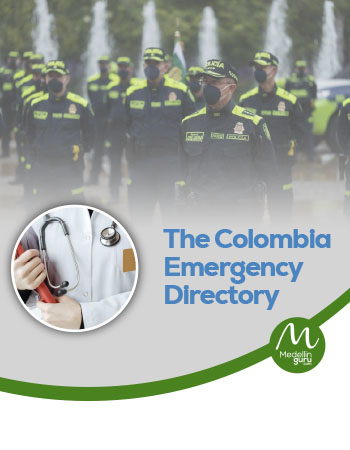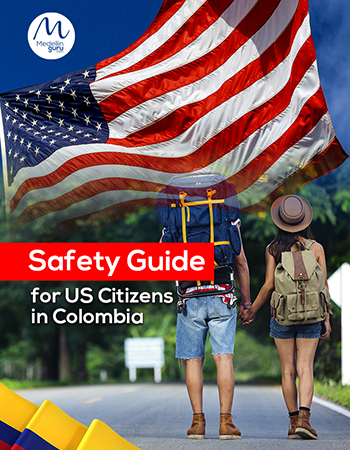Medellín has the only rail-based metro system in Colombia. But this mass transportation system is much more than a rail-based system.
Medellín’s metro system is a comprehensive transportation system that integrates two rail lines, a Tranvía tramcar line, six Metrocable cable-car lines, two Metroplús elongated bus line an electric bus line and even hundreds of small feeder metro buses. This system in Medellín consists of:
- Two rail lines – Line A (north to south) with 21 stations and Line B (center to west) with six stations.
- Seven Metrocable cable car lines – Line H with two stations, Line J with three stations, Line K with three stations, Line M with three stations and Line L with two stations and the newest line P with three stations.
- One Tranvía tramcar line – Line T-A with nine stations.
- Two Metroplús elongated bus lines – Line 1 with 20 stations and Line 2 with eight stations.
- Line O – an electric bus line with 80 buses going from the Caribe metro station to the La Palma Metroplús station with 14 stops.
- Over 200 metro feeder buses that connect to/from the metro stations with routes to and from many neighborhoods in the Medellín metropolitan area, also known as the Aburrá Valley.
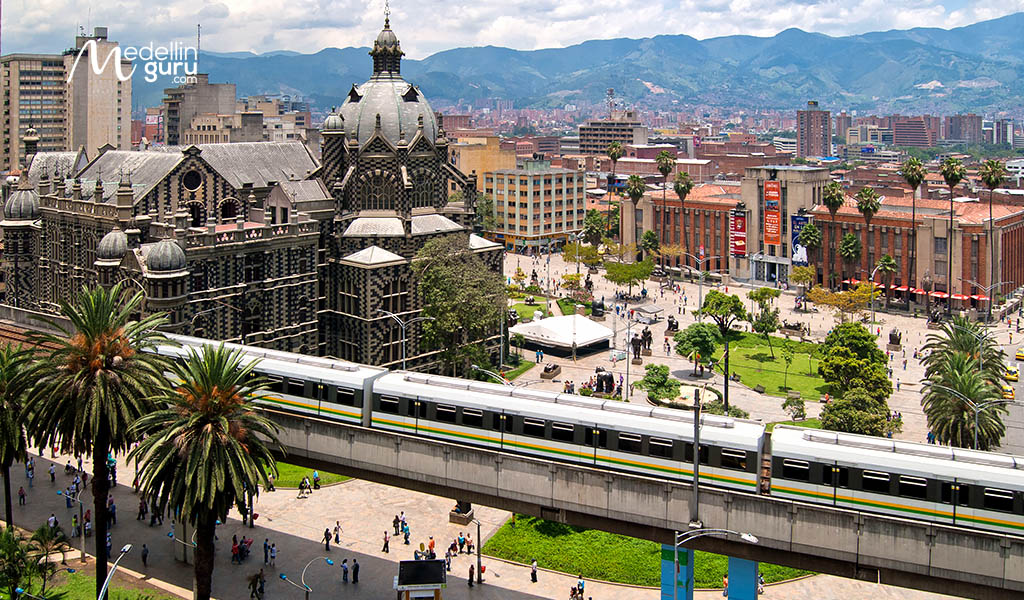
New 2025 Medellín Metro System Fares
The 2025 standard Medellín Metro fare with a personalized Cívica card is 3,430 pesos ($0.82 USD), which is up from 2,310 pesos in 2024.
The standard fare in 2025 if you don’t have a personalized Civica card is 3,900 pesos ($0.93 USD), which is up from 3,650 pesos in 2024. The standard fare is the fare with the eventual Civica cards that are sold at fare booths at metro stations. It now costs 10,900 pesos to get an eventual Civica card at a fare booth that is rechargeable.
The Metrocable line to Parque Arvi (Line L) has a separate fare of 13,700 pesos unless you are part of Sisbén, which will result in a lower fare.
The following is the official table of 2025 fares from the Metro website:

Furthermore, discounted fares are available as shown in the table for those over 60 years old (Adulto Mayor), students (Estudiantial), people with reduced mobility (PcD) and package carriers (Al Portador). When you sign up for a Civica card you can establish the discounted fares for your Civica card if you are eligible.
However, if you receive a discount you can’t use your Civica card for other passengers. For example if you sign up for a discount for being over 60 years old, the card only works once and won’t work again for the same entrance for about 30 minutes. This is to prevent people with discounts from providing discounted fares to others who aren’t eligible.
Integrated Metro Fares for 2025
The integrated fares for integrated buses and the metro have also changed and range from 3,890 to 5,920 pesos.
The integrated buses now have Cívica readers. You will need a Civica card to get the integrated fare. And if you pay the integrated bus driver with cash you can’t get the lower integrated fare.
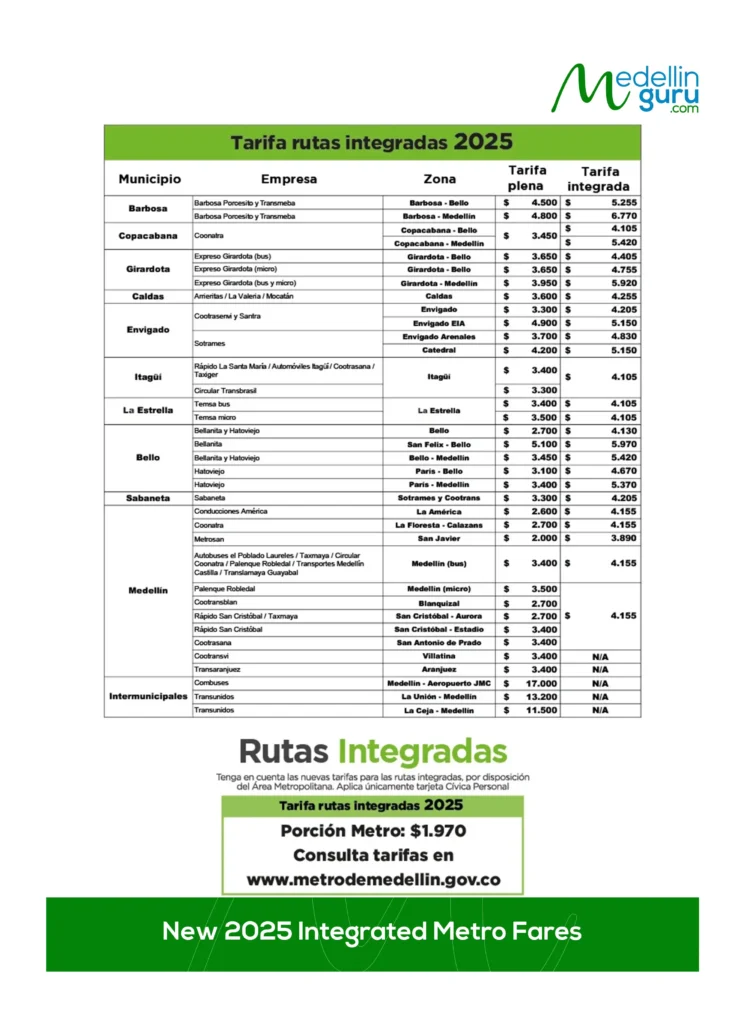
Medellín Metro System Hours
The Medellín Metro system is open from Monday to Saturday each week from 4:30 am until 11 pm for all lines except for Line L to Parque Arvi.
On Sundays and most holidays, the hours are from 5 am to 10 pm. And 8:30 am to 10 pm on Line K and 9 am to 10 pm on Lines H, J and M.
The Metrocable line to Parque Arvi (Line L) runs from 9 am to 6 pm on Monday to Saturday. On Sunday and holidays Line L runs from 8:30 am to 6 pm.
Also, during Christmas, the operating hours of the metro are typically expanded to impulse the visits to the Christmas Lights.
How to Get and Use a Medellín Metro Cívica Card
A Cívica Card is a Medellín Metro system card for users that is rechargeable. If you use this card, you can save time by avoiding the long ticket lines. In addition, you save money with lower fares.
Eventual Cívica Card
This Cívica is selled at metro station ticket booths, which now cost 10,000 pesos
Personalized Cívica Card
This Cívica is selled at metro station ticket booths, which now cost 10,900 pesos
Furthermore, it doesn’t cost anything to get a personalized Civica card. You can get it at the Itagüí, Niquía, San Antonio and San Javier metro stations. The small offices issuing personalized Civica cards are open Monday to Friday 6:30 am to 8:30 pm, or on Saturday from 9:30 am to 4:30 pm.
To get the card you just need to show an ID such as Colombian cédula, passport, driver licence, student ID (university photo ID), or birth certificate.
A Cívica card initially will have no value but you can recharge it by standing in ticket lines at any metro station. In addition, there are some recharging machines at some metro stations. The personalized card is green and will have your name printed on it.
A Cívica personalized card is different than the eventual rechargeable cards issued at metro station ticket windows that are full fare cards and the cards issued at ticket windows won’t have your name on them. You need a personalized Cívica card with your name on it to get the lower Frequente fare.
Since the eventual Civica cards now costs 10,900 pesos and has the full fare, it makes no sense to use these. Instead get the personalized one for free and you will have a lower metro fare.
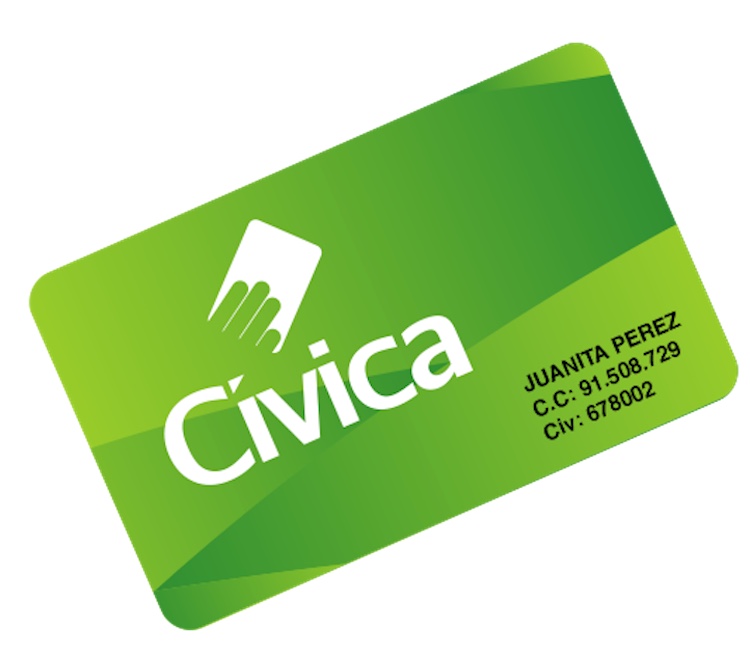
Additionally, there are many options to recharge your card, at some Metro points for example and also virtually, here you can learn more. The Cívica card can also be used on the white integrated feeder buses that have this type of readers. If an integrated bus has a reader you can’t use integrated tickets for the lower fare bus/metro combination. And buses with a card reader only have the lower integrated fare available if you use a Civica card.
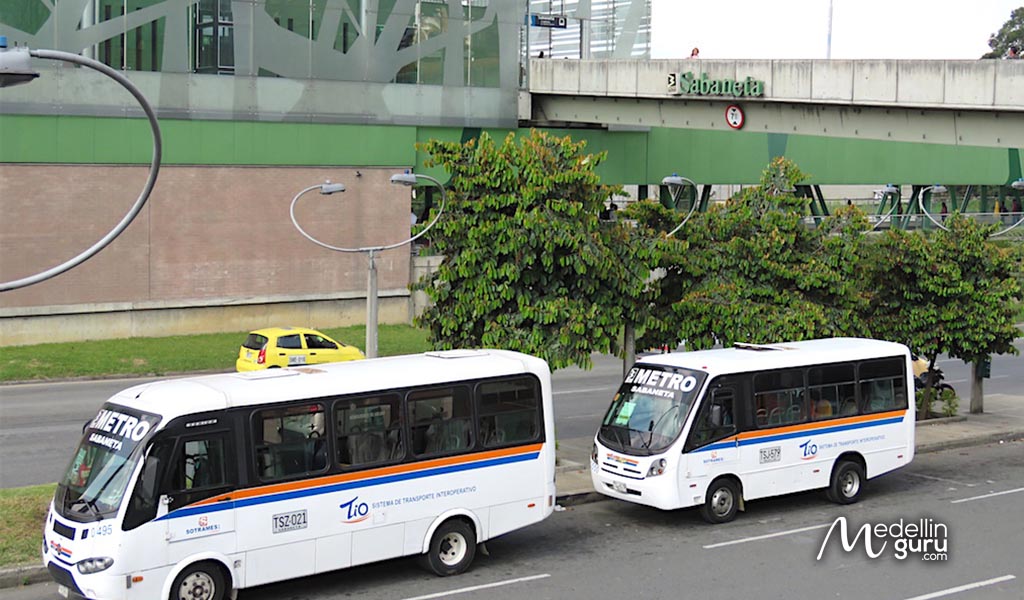
The Cívica card is also used in the Encicla system, which is Medellín’s free city bikes system that permits you to borrow bikes from many stations throughout the city. Also, we have a guide to using and signing up for Encicla.
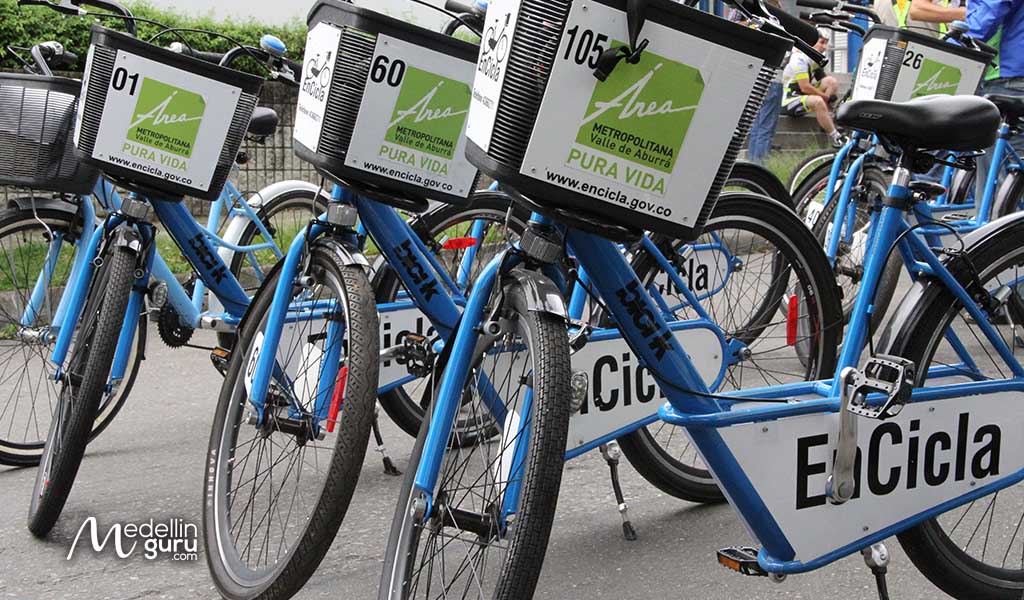
In addition, there at least one debit card that is multiple purpose and is also a Cívica card, Bancolombia has one.
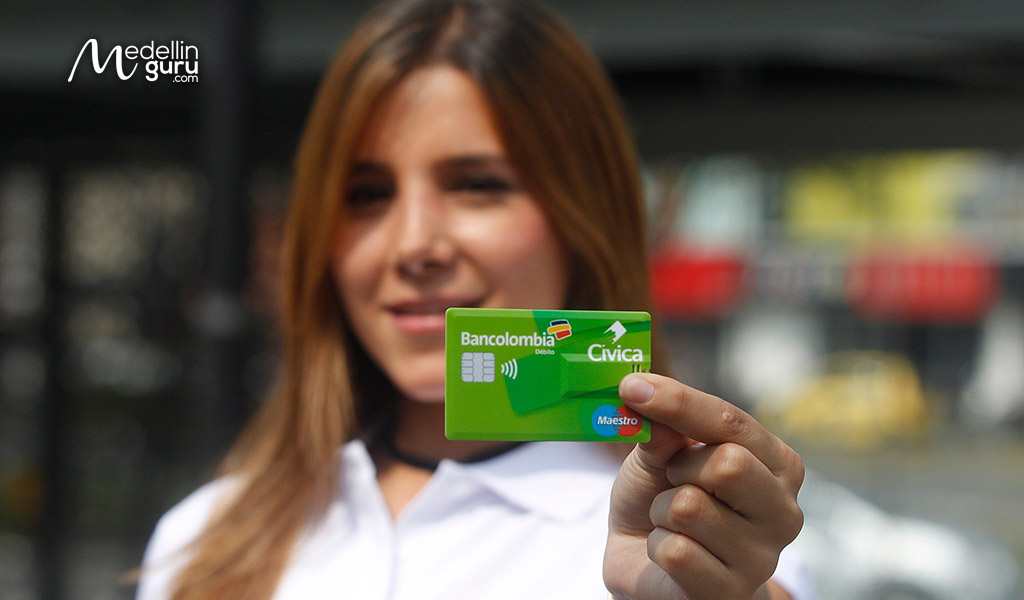
Considering that you save money, I don’t understand why there frequently are people standing in long lines to buy tickets.
Individual trip tickets are put on a card that is charged with one or more trips. You can buy one trip or additional trips in advance. When the card has no more money you deposit it in a slot. But a Cívica card is rechargeable and has lower fares.
Using the Medellín Metro as a Tourist
If you are a tourist, you can use the metro system to get to many of the most popular tourist spots in Medellín. In addition, seven of the shopping malls in Medellín are located within a block or just a few blocks from a metro station. The following is a list of metro stations and several key tourist spots located nearby:
Parque Berrio Station
So, it is possible and convenient to get to many tourist spots and shopping malls in the metropolitan area by using the metro system. The Medellín Metro even provides a tourist guide (in Spanish) showing additional tourist spots you can get to using the metro system.
Also, Medellin Guru has prepared two downloadable PDF guides to make your stay the best, absolutely safe, and referencing everything you need to keep in mind to safeguard your well-being, health, and experience.
History of the Medellín Metro System
The history of the Medellín Metro system traces back to 1980, when the project was presented to the Colombian National Government by the city of Medellín. The project was approved in 1982 by the National Council of Economic and Social Policies.
The Medellín Metro was conceived as a major urban transportation system for the worker classes in Medellín. In addition, it was envisioned to help develop marginalized portions of the city with limited transportation options, which are also some of the poorest neighborhoods in the city.

The massive construction project was contracted to German and Spanish firms in 1984. And the first journey on the Line A rail line was on November 30, 1995 between the Niquia and Poblado stations.
The system has continued to expand since the first rail line was installed. The Line B rail line was added in February 1996. And Line A was expanded south in 2012 to add the Sabaneta and La Estrella stations.
In July 2004, the first Metrocable Line K was added. And in March 2008, the second Metrocable Line J was added. In September 2010, Line L to Parque Arvi was added. And in December 2016, the fourth Metrocable Line H was added.
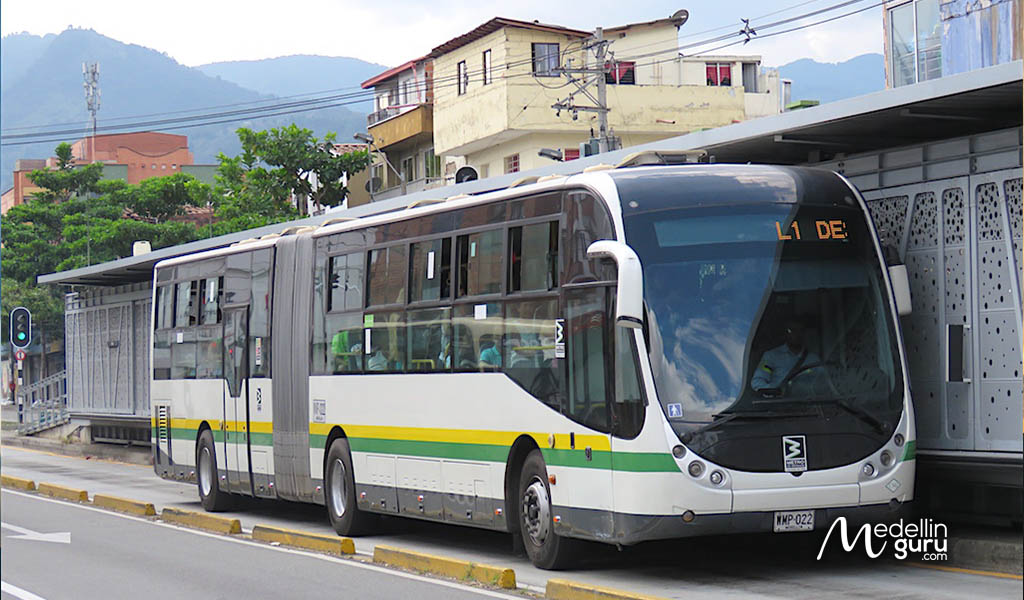
The first Metroplús bus elongated bus line, Line 1, was added in December 2011 and Line 2 was added in April 2013. In addition, the Tranvía tramcar Line T-A officially started service in March 2016 but it opened earlier for trial runs.
Also, in 2018 the system added monitors at many of the stations that show a color-coded status of the metro line and how much time until the next trains arrive.

Metrocable Line M completed construction in January 2019 and opened on February 13, 2019
The latest addition is the fifth Metrocable Line M that completed construction in January 2019 and is was tested before becoming operational on February 13, 2019. Line M has three stations and 49 cable cars and connects to the Tranvía tramcar Line T-A at Miraflores station.
Since 2023, the possibility of building another line for the San Antonio de Prado Metrocable started to be evaluated, to continue connecting all the towns of the city.
The Medellín Metro system was named one of the top transport systems in the world by the Institute for Transportation and Development Policy (ITDP) in 2012. ITDP is global consortium of organizations founded to promote sustainable transportation systems worldwide.
It is estimated that the Medellín Metro transports around 800,000 people daily. In addition, the metro reportedly saves over 200,000 tons of CO2 emissions each year. In addition, it greatly reduces the amount of traffic in the city and the number of traffic accidents each year. For example, the new tramline reportedly eliminated the need for over 200 buses.

The Future of the Medellín Metro
The Medellín Metro has a long-range master plan in place. In this master plan are many more planned expansions to the metro system.
The tranvía tramline T-A opened in early 2016. And the newest Metrocable line M opened in February 2019, 2019. These two expansions were part of the master plan. Near term expansions already in work include:
- Expand the Poblado station
- Complete the fifth Metrocable – line M (completed construction in January 2019 and opened on February 13, 2019)
- Add the third Metroplús elongated bus line between Envigado and Itagüí
- Add the sixth Metrocable – line P (completed construction in June 2021 and opened in June)
- Add a light rail along Avenida 80 running from Aguacatala to Caribe station
Also, they have been adding trains to the system to increase capacity. Additional trains added recently have reduced the time between trains during peak hours on Line A from every 3 minutes, 45 seconds to every 3 minutes.
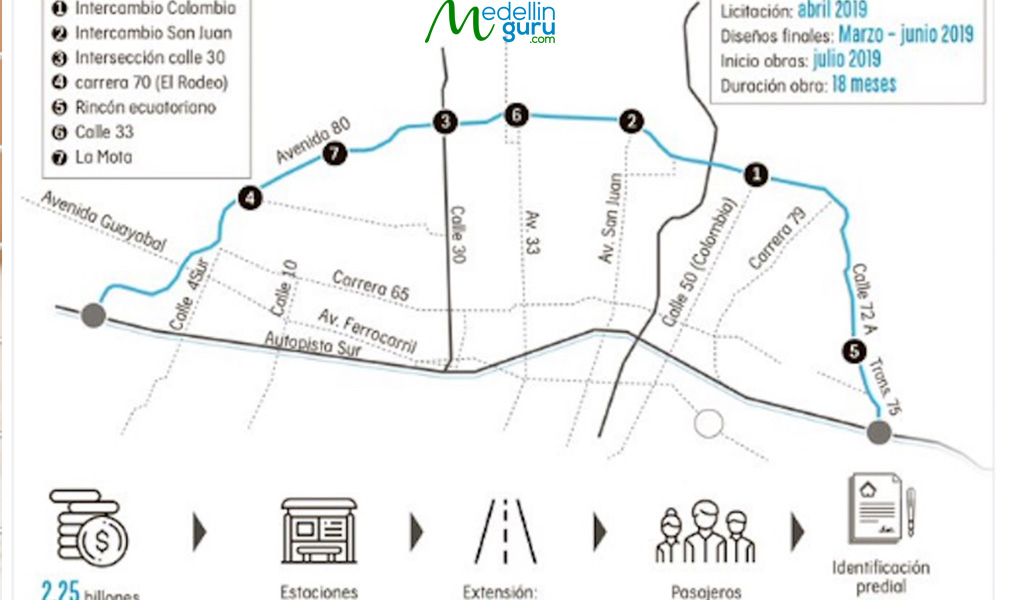
Medellín is also working on a major expansion of the metro system that is a light rail project along Avenida 80 running from Aguacatala to Caribe station. The initial phase is budgeted at 1.3 billion pesos and will connect the Caribe metro station to the Floresta metro station.
Other expansions reportedly planned in the next few years include adding additional stations to Line A (between the Industriales and Poblado stations and between the Envigado and Itagüí stations).
Longer term expansions planned in the next 10+ years include adding a line from El Poblado to the South Bus Terminal, adding a tramline to José María Córdova international airport and adding a cable car system in Itagüí. In addition, a regional train system is in the planning stages.
So, more expansions are coming, which will continue to improve the public transportation system in Medellín.

Medellin Metro Tips
Here are some tips for using the Medellín Metro:
-
Get a Civica Card
It doesn’t take much time to get one and you will save over 11 percent on fares plus you will avoid standing in the long ticket lines. Also, to get the integrated fare on integrated feeder buses with Civica readers you need a Civica card.
-
Use a money belt or hidden pouch to prevent theft
You should be careful not to store your personal items in the clothes you are wearing. Pockets of jeans, pants, jackets or shirts are the most common targets for theft.
-
Watch your belongings
Unscrupulous people take advantage and commit crimes. Take particular care with smart phones, which are among the most commonly stolen items in Medellín. See our aticle on security for more safety tips
-
Traveling on the metro is generally safe
However, watch out for pickpockets during rush hour or any time the trains are packed full of people. Also, watch out for people taking things from backpacks or bags. Several years ago, I lost a small camera that was in the small pocket in a backpack during rush hour. In addition, I recently had a phone stolen by a pickpocket during rush hour on the metro.
-
The worst time to use the metro is during the evening rush on Monday to Friday
During this time trains are packed like sardines. So, try to avoid this evening rush hour. During the evening rush hours from about 5 pm to 7 pm, it could take you two to three trains to get on at busy stations like San Antonio or Poblado and you will be packed in like sardines.
-
Learn the integrated bus routes
You can get to and from many neighborhoods in the Medellín metropolitan area on the integrated buses. For example, I can conveniently catch a bus outside my apartment building in Sabaneta and be at a metro station in less than 10 minutes. Furthermore, the buses will have the route/stops listed on signs in the front window.
-
Get a Health Insurance
Traveling to a new place can be overwhelming, and safety is always a top priority. It's essential to remain vigilant and cautious to ensure you have a great experience in the country. An assistance policy covering various events, like document loss or medical emergencies, can provide peace of mind during your time in Medellin.
Click on the green button to get the health policy through the partnership with EG Insurance
Are Pets Permitted on the Medellín Metro?
Yes, pets are permitted on the Medellín Metro system but there are some restrictions. Pets like dogs and cats can be taken on the Medellín metro system on Monday to Friday between 9:00 am and 3:00 pm and on Saturdays, Sundays and holidays between 9:00 am and 12:00 noon. During these hours pets are permitted on all parts of the metro system.

In addition, the pet must be in a crate, container or cage with maximum measures that are 60 cm wide, high and deep, which must be located on the floor and be solid enough to prevent it from escaping.
Are Bicycles Permitted on the Metro?
Yes, bicycles are permitted on the Medellín Metro system but there are restrictions. The metro system permits conventional bicycles on the trains of Lines A and B only during certain times of operation.
Cyclists may enter Line A and B trains with their bicycles on Monday through Friday between 8:00 pm and 11:00 pm, Saturdays from 4:00 pm to 11:00 pm and on Sundays and holidays from 5:00 am to 10:00 pm. In no case is there a need to pay an additional fare for bicycles.
For metrocable, bicyclists must only occupy the spaces marked for them in the train cars, and in the Metrocable cabins they must wait for the Station Operator to raise the gondola benches to enter with their bicycle diagonally and with both tires on the ground. If you want to visit the Arví Park, to do some cyling, you can avoid this and use the bicycles in rent there.

The most appropriate place to locate bicycles is the end of each train car with a space that is marked. Also, cyclists must yield to people with reduced mobility who require it.
In addition, cyclists must travel through metro stations and trains on foot and give priority to other users when entering and leaving trains. Furthermore, cyclists are not be able to use the elevators or the escalators to move, nor can they travel in train cars in which there are more than two bicycles.
Medellin Guru's comprehensive Colombian culture series
In Medellin Guru, we love Colombia, and we usually write many blogs about Colombian culture, places to visit, and other tips for all expats to have a reliable guide and valuable and relevant information about Colombia. Read our blogs about Colombian Culture here:
- Top Tourist Attractions in Colombia: Top Things to Do
- Top Things to Do in Medellín and Nearby: Top Tourist Attractions
- How to be an Expat in Colombia: 12 Tips to be a Successful Expat
- Top Things to Do in Cali and Nearby: Top Tourist Attractions
- Celebrating July 20th: Colombia Independence Day
- Norte de Santander: 5 Escapes for a Weekend Adventure
- Unlock Ipiales in 24 Hours: Your Essential Adventure Blueprint!
- Pasto: Discover the wonders of the Surprise City
- Top Popular Colombian Drinks to Try When You Visit Colombia
- Villa de Leyva: A Colonial Gem in the Colombian Andes
- Traditional Colombian Food Dishes You Must Try in Colombia
- Medellin Guru Launch 2023: Gentrification, Tourism and Investment
- Popular Colombian Desserts You Must Try While in Colombia
- Exotic Tropical Fruits of Colombia a Fruit Lovers Paradise
- Popular Colombian Soups to Try When You Visit Colombia
- Día de las Velitas: Day of Candles Tradition in Colombia on December 7
- Things in Colombia That May Be Strange for Foreigners
- Things Colombians Do That Foreigners May Find Weird
- Popayán: A Well-Preserved Colonial Gem in Colombia Worth Visiting
- Tejo: A Colombian Game That Rewards You for Explosions
Other things to see and do in Colombia
- Caño Cristales – the most beautiful river in Colombia, which has also been called the most beautiful river in the world by some people.
- Carnival in Barranquilla – the second largest carnival in the world.
- Cartagena – Oozing history, romance and sun-drenched beaches, the allure of historical Cartagena is hard to resist.
- Ciudad Perdida – the site of an ancient city in Colombia that is older than Machu Picchu in Peru.
- Colombia’s Pacific coast – often overlooked by tourists visiting Colombia but offering untamed nature and undiscovered beauty that is off the beaten path for most foreign tourists.
- Desierto de la Tatacoa – the second largest arid zone in Colombia is Tatacoa Desert, which has surreal desert landscapes and some of the best stargazing in Colombia.
- Guatapé – a picturesque pueblo near Medellín known for its huge rock and lake. And it’s likely the most visited pueblo in Colombia by foreigners.
- La Guajira Peninsula – one of the most visually stunning places in South America, which is located on the northern tip of Colombia where the desert meets the sea.
- Las Lajas Sanctuary – the most beautiful church in Colombia, which has also been called the most beautiful church in the world.
- Medellín’s Christmas lights – Medellín’s annual world-class Christmas lights known as Alumbrados Navideños.
- Feria de Las Flores Medellin – Medellín’s world-famous flower festival each year.
- Parque Nacional Natural Los Nevados – a popular national park in Colombia located in the heart of the Colombian coffee region.
- Parque Tayrona – known for its beautiful beaches and the world’s highest coastal mountain range.
- Popayán – a colonial gem in Colombia best known for its white buildings and churches, it’s a city off the beaten path for foreign tourists but is definitely worth visiting.
- Rio Claro Nature Reserve – located about three hours from Medellín, Rio Claro is the perfect place to unplug from hectic daily life and enjoy a picturesque crystal-clear river, canyon and tropical rainforest.
- Salento and the Cocora Valley – Salento is a picturesque pueblo in Colombia’s coffee region and the nearby Cocora Valley is one of the most striking landscapes found in Colombia.
- San Agustín Archaeological Park – the largest group of pre-Columbian monuments and megalithic statues in South America and is a UNESCO World Heritage Site.
- San Andrés – Colombia’s Caribbean island which is a UNESCO World Biosphere Reserve featuring many beaches, islets and coral reefs that are filled with flora and fauna.
- San Gil – Colombia’s adventure capital that is full of things to do including white water rafting, paragliding, caving, rappelling, hiking and much more.
- San Jose del Guaviare – a hidden gem and eco-tourism location off the beaten path and offering wildlife watching, jungle trekking and delving into Colombia’s prehistoric past.
Medellin Guru Guides
Download the guide Colombia: a must-see destination from ProColombia with helpful information about Medellín and Colombia
The Bottom Line: The Medellín Metro System
The Medellín Metro is considered a symbol for Medellín. And it is still the only rail-based metro system in Colombia. With its comprehensive transportation system, Medellín arguably has a world-class public transportation system that is considered the best out of all the cities in Colombia.
Other cities in Colombia only have elongated bus systems like TransMilenio in Bogotá, MIO in Cali, Metrolinea in Bucaramanga and Megabús in Pereira.
The largest city in Colombia, Bogotá, has been talking about and planning a rail-based metro for decades and still just a proposal that isn’t projected to be operational until perhaps 2024 at the the earliest.
With the inexpensive Medellín Metro system, extensive bus routes in the city with inexpensive fares as well as inexpensive taxis it is very possible to live in Medellín without a car. The good and inexpensive public transportation in the city is one of 27 reasons I chose to live in Medellín.
I have lived in Medellín for over eight years without a car and never even found the need to rent a car. And reportedly over 80 percent of expats living in Medellín don’t have a car.
Medellin Guru Social media
Be part of our community. Find out about news, participate in events and enjoy the best of the city.


